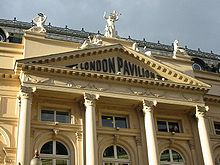London Pavilion
| 1859 London Pavilion Music Hall | |

Façade of the London Pavilion in 2002
|
|
| Address |
Shaftesbury Avenue Westminster, London |
|---|---|
| Coordinates | 51°30′37″N 0°08′02″W / 51.510278°N 0.133889°W |
| Owner | Burford Group |
| Designation | Grade II listed |
| Current use | Trocadero Centre |
| Construction | |
| Opened | 1859 |
| Rebuilt | 1900 & 1918 Wylson & Long 1934 converted to cinema by F Chancellor |
| Years active | 1859–1934 |
| Architect | James Ebenezer Saunders and Robert Worley (1885) |
| Website | |
| www.londontrocadero.com | |
The London Pavilion is a building on the corner of Shaftesbury Avenue and Coventry Street on the north-east side of Piccadilly Circus in London. It is currently a shopping arcade and part of the Trocadero Centre.
The first building bearing the name, a music hall formed from roofing the yard of the Black Horse Inn, was built in 1859 for Emil Loibl and Charles Sonnhammer. A gallery was constructed for the hall but it could not utilise the full width, because one part of the premises was used by Dr Kahn's "Delectable Museum of Anatomy".
In 1885 Shaftesbury Avenue was built through part of the site, and a new London Pavilion Theatre was constructed. This opened on 30 November 1885 with a popular revue. The new theatre was the first 'music hall deluxe', with marble-topped tables for dining in the auditorium. According to Charles Stuart and A.J. Park in The Variety Stage (1895) the rebuilding signalled a new era of variety theatre:
Hitherto the halls had borne unmistakable evidence of their origins, but the last vestiges of their old connections were now thrown aside, and they emerged in all the splendour of their new-born glory. The highest efforts of the architect, the designer and the decorator were enlisted in their service, and the gaudy and tawdry music hall of the past gave way to the resplendent 'theatre of varieties' of the present day, with its classic exterior of marble and freestone, its lavishly appointed auditorium and its elegant and luxurious foyers and promenades brilliantly illuminated by myriad electric lights
The success of the venture led its owner, Villiers, to form a limited company; this became the first combine of music halls, Syndicate Halls Ltd. Lupino Lane made his London début here in 1903, as "Nipper Lane".
Between 1912 and 1936 the theatre presented a regular programme of musicals; these included Noël Coward's first success, On With the Dance in April 1925. There were appearances by Sir Harry Lauder; in October 1921 the American actor and vocalist Clifton Webb appeared here in The Fun of the Fair and again in October the following year as Phidas in Phi-Phi. In 1923 electric billboards were erected for the first time on the side of the building.
...
Wikipedia
